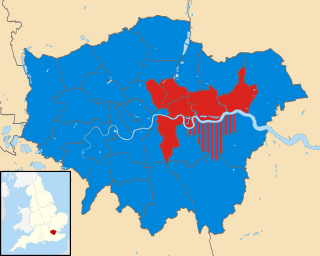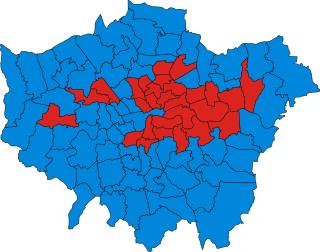| | |||||||||||||||||||||||||||||||
| |||||||||||||||||||||||||||||||
100 councillors 51 seats needed for a majority | |||||||||||||||||||||||||||||||
|---|---|---|---|---|---|---|---|---|---|---|---|---|---|---|---|---|---|---|---|---|---|---|---|---|---|---|---|---|---|---|---|
| |||||||||||||||||||||||||||||||
 Results by electoral division | |||||||||||||||||||||||||||||||
| |||||||||||||||||||||||||||||||
The third election to the Greater London Council was held on 9 April 1970 and saw a Conservative victory with a reduced majority.
| | |||||||||||||||||||||||||||||||
| |||||||||||||||||||||||||||||||
100 councillors 51 seats needed for a majority | |||||||||||||||||||||||||||||||
|---|---|---|---|---|---|---|---|---|---|---|---|---|---|---|---|---|---|---|---|---|---|---|---|---|---|---|---|---|---|---|---|
| |||||||||||||||||||||||||||||||
 Results by electoral division | |||||||||||||||||||||||||||||||
| |||||||||||||||||||||||||||||||
The third election to the Greater London Council was held on 9 April 1970 and saw a Conservative victory with a reduced majority.
New constituencies to be used for elections to Parliament and also for elections to the GLC had not yet been settled, so the London boroughs were used as multi-member 'first past the post' electoral areas. Westminster was joined with the City of London for this purpose. Each electoral area returned between 2 and 4 councillors.
The Conservative Party won a majority of seats at the election.
With an electorate of 5,524,384, there was a turnout of 35.2%. [1] [2] Labour recovered from its mauling three years previously, but did so primarily in working-class areas. Consequently, relatively few seats changed hands: Labour won back Camden, Greenwich, Hammersmith, Lewisham, Wandsworth, and one seat in Lambeth. The results did enable Labour to take back control of the Inner London Education Authority and were one of the factors used by Prime Minister Harold Wilson in deciding to call a general election soon after.
Among those who were first elected to the GLC in 1970 were Tony Banks (Labour, Hammersmith, later Minister for Sport) and Sir George Young (Conservative, Ealing, later a cabinet minister under John Major). The election is also significant as it was at a meeting in support of the Conservative candidates in Lambeth that John Major met Norma Johnson, who became his wife.
| Party | Votes | Seats | ||||||
|---|---|---|---|---|---|---|---|---|
| Number | % | +/- | Stood | Seats | % | +/- | ||
| Conservative | 971,227 | 50.6 | 100 | 65 | 65.0 | |||
| Labour | 766,272 | 39.9 | 100 | 35 | 35.0 | |||
| Liberal | 103,838 | 5.4 | 100 | 0 | ||||
| Communist | 33,869 | 1.8 | 40 | 0 | ||||
| Homes before Roads | 23,854 | 1.2 | n/a | 85 | 0 | |||
| Union Movement | 10,432 | 0.6 | 32 | 0 | ||||
| Independent | 6,450 | 0.3 | 9 | 0 | ||||
| Socialist (GB) | 1,656 | 0.1 | 14 | 0 | ||||
| Independent Liberal | 1,250 | 0.1 | n/a | 1 | 0 | |||
| John Hampden New Freedom Party | 552 | 0.0 | 1 | 0 | ||||
| New Liberal | 438 | 0.0 | n/a | 3 | 0 | |||
| Movement for People's Democracy | 405 | 0.0 | n/a | 1 | 0 | |||
| All Night Party / Bread and Circuses Party / Campaign for Non-Political Social Awareness 1 | 177 | 0.0 | n/a | 5 | 0 | |||
1 These parties were created by a group of students standing in Haringey, who declared that they intended to make a mockery of the election.
In addition to the 100 councillors, there were sixteen aldermen elected by the council. Eight aldermen elected in 1967 continued to serve until 1973 and eight elected in 1964 retired before the 1970 election. Eight aldermen were elected by the council on 28 April 1970 to serve until 1976.
Aldermen elected in 1970, to retire in 1976: [lower-alpha 1]
| Party | Alderman | |
|---|---|---|
| Conservative | Frank Lewis Abbott | |
| Conservative | Francis Ernest Herman Bennett | |
| Conservative | Leslie Freeman | |
| Labour | Arthur James Hichisson | |
| Conservative | Thomas Ponsonby | |
| Labour | Reginald Prentice [lower-alpha 2] | |
| Conservative | Lena Townsend | |
| Conservative | Gerard Folliott Vaughan [lower-alpha 3] | |
The aldermen divided 11 Conservative and 5 Labour, so that the Conservatives had 76 members to 40 for Labour following the aldermanic election.
No seats changed hands in byelections during this term. The Conservatives retained Kensington and Chelsea on 2 December 1971 after the death of Seton Forbes-Cockell, and Barnet on 19 October 1972 after the death of Arthur Peacock. Labour retained Wandsworth on 15 June 1972 after the death of Sir Norman Prichard. No seats were vacant at the end of the term.

The Greater London Council (GLC) was the top-tier local government administrative body for Greater London from 1965 to 1986. It replaced the earlier London County Council (LCC) which had covered a much smaller area. The GLC was dissolved in 1986 by the Local Government Act 1985 and its powers were devolved to the London boroughs and other entities. A new administrative body, known as the Greater London Authority (GLA), was established in 2000.

The first election to the Greater London Council (GLC) was held on 9 April 1964.

The second election to the Greater London Council was held on 13 April 1967, and saw the first Conservative victory for a London-wide authority since 1931.

The fourth election to the Greater London Council (GLC) was held on 12 April 1973. Labour won a large majority of 58 seats to 32 for the Conservatives; the Liberals also won their first two seats on the council.

The fifth election to the Greater London Council (GLC) was held on 5 May 1977. The Conservatives, led by Horace Cutler, gained control of the council from Labour.
An election to the County Council of London took place on 6 March 1919. It was the tenth triennial election of the whole Council. The size of the council was increased to 124 councillors and 20 aldermen. The councillors were elected for electoral divisions corresponding to the new parliamentary constituencies that had been created by the Representation of the People Act 1918. There were 60 dual-member constituencies and one four-member constituency. The council was elected by First Past the Post, with each elector having two votes in the dual-member seats.
The 1964 Lambeth Council election took place on 7 May 1964 to elect members of Lambeth London Borough Council in London, England. The whole council was up for election and the Labour party gained control of the council. The election is notable for being the first one ever fought by John Major.

The 2018 London local elections took place in London on 3 May 2018 as part of wider local elections in England. All London borough councillor seats were up for election. Elections to the Corporation of London were held in 2017. Mayoral contests were also held in Hackney, Lewisham, Newham and Tower Hamlets. The previous London borough elections were in 2014.
Norwood was an electoral division for the purposes of elections to the Greater London Council. The constituency elected one councillor for a four-year term in 1973, 1977 and 1981, with the final term extended for an extra year ahead of the abolition of the Greater London Council.
Vauxhall was an electoral division for the purposes of elections to the Greater London Council. The constituency elected one councillor for a four-year term in 1973, 1977 and 1981, with the final term extended for an extra year ahead of the abolition of the Greater London Council.
Lambeth Central was an electoral division for the purposes of elections to the Greater London Council. The constituency elected one councillor for a four-year term in 1973, 1977 and 1981, with the final term extended for an extra year ahead of the abolition of the Greater London Council.
Streatham was an electoral division for the purposes of elections to the Greater London Council. The constituency elected one councillor for a four-year term in 1973, 1977 and 1981, with the final term extended for an extra year ahead of the abolition of the Greater London Council.
Battersea North was an electoral division for the purposes of elections to the Greater London Council. The constituency elected one councillor for a four-year term in 1973, 1977 and 1981, with the final term extended for an extra year ahead of the abolition of the Greater London Council.
Battersea South was an electoral division for the purposes of elections to the Greater London Council. The constituency elected one councillor for a four-year term in 1973, 1977 and 1981, with the final term extended for an extra year ahead of the abolition of the Greater London Council.
Putney was an electoral division for the purposes of elections to the Greater London Council. The constituency elected one councillor for a four-year term in 1973, 1977 and 1981, with the final term extended for an extra year ahead of the abolition of the Greater London Council.
Tooting was an electoral division for the purposes of elections to the Greater London Council. The constituency elected one councillor for a four-year term in 1973, 1977 and 1981, with the final term extended for an extra year ahead of the abolition of the Greater London Council.
Fulham was an electoral division for the purposes of elections to the Greater London Council. The constituency elected one councillor for a four-year term in 1973, 1977 and 1981, with the final term extended for an extra year ahead of the abolition of the Greater London Council.
Hammersmith North was an electoral division for the purposes of elections to the Greater London Council. The constituency elected one councillor for a four-year term in 1973, 1977 and 1981, with the final term extended for an extra year ahead of the abolition of the Greater London Council.
Lewisham West was an electoral division for the purposes of elections to the Greater London Council. The constituency elected one councillor for a four-year term in 1973, 1977 and 1981, with the final term extended for an extra year ahead of the abolition of the Greater London Council.